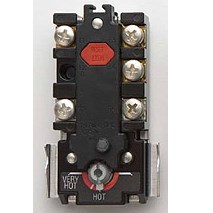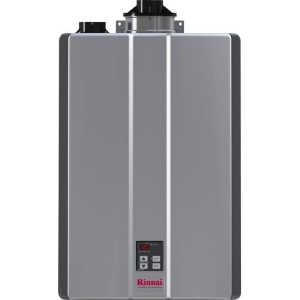Understanding Why Your Electric Water Heater's Reset Button Keeps Tripping
When the reset button on your electric water heater keeps tripping, it's more than just a minor annoyance-it's a clear indication that there's an underlying issue demanding attention.
Having hot water at our disposal is one of those conveniences of modern living we often don't think twice about, until suddenly, we're faced with cold showers and unheated water for chores.
This disruption can quickly turn into a significant inconvenience, prompting an urgent investigation into the cause.
In this article, we will talk about the reasons why your electric water heater's reset button may persistently trip and offer insights on how to address this issue, ensuring the continuous flow of hot water that is so essential to our daily comfort and convenience.
What is the reset button?

First, it's essential to understand what the reset button on electric water heaters does.
Also known as the ECO (Emergency Cut Off) switch or high-temperature cutoff, this button is a safety feature designed to prevent the water heater from overheating and protect you from scalding burns. When the water temperature inside the tank exceeds a safe level (150°F - 180°F), the reset button trips, shutting off power to the heater.
Resetting the button will restore power, but if it trips again, it indicates an underlying problem that needs attention.
When you press the reset button, you can hear a metallic "click" sound.
Where is it located on a water heater?
The reset button on an electric water heater is typically located behind a panel on the side of the tank. To access it, you may need to remove a protective cover or insulation. It's usually found near the thermostat controls for the upper heating element.
In most models, there are two panels on the side of the water heater tank; the reset button is behind one of these panels. After removing the outer panel, you might see insulation that needs to be gently moved aside to reveal the reset button.
This button is often red or high-visibility color to make it easy to identify. Remember to turn off the power to the water heater at the circuit breaker before attempting to access the reset button for safety reasons.
Understanding the ECO mechanism
During regular operation, the contacts beneath the reset button allow electrical current to flow from one terminal to another, a process verifiable with a voltmeter.
In the event of abnormal operation, as observed in models like the Rheem electric water heater, the plate under the button changes shape. This action pushes out a pin, triggering the Emergency Cut Off (ECO) to trip. Under these circumstances, a voltmeter will register no current flow between the terminals or to the heating elements.
Before attempting to reset the ECO, it's essential to allow the water inside the tank to cool down. A helpful tip is to run hot water from a nearby faucet to expedite the cooling of the tank.
It's assumed that the wiring and the electrical panel with breakers have been correctly installed and adhere to codes. If the setup appears suspicious, it's advisable to have an electrician check the wire and breaker sizes to ensure they are appropriate.
Why the reset button keeps tripping
Faulty thermostat
A common cause for the reset button on your water heater to keep tripping is a faulty thermostat, which plays a pivotal role in regulating the unit's temperature.
When the thermostat malfunctions, it may fail to accurately measure the water's temperature and get locked in the ON position, continuously powering one of the heating elements.
This constant heating can cause the water to exceed the high limit temperature, prompting the reset button to trip as a safety measure.
Testing the thermostat with a multimeter to verify its proper operation is crucial in diagnosing this issue.
If the thermostat is found to be faulty, replacing it becomes essential to ensure accurate temperature regulation and prevent the water heater from overheating, addressing the root cause of the tripping reset button.
Loose wiring
Loose or damaged wiring within the water heater can lead to a host of problems, including short circuits, overheating, and consequently, the tripping of the reset button.
Loose wire connections not only generate heat but can also result in burned wires, melting, smoke, and can adversely affect the thermostat, triggering the Emergency Cut Off (ECO) mechanism.
A thorough inspection of all wiring connections for tightness and integrity is crucial to prevent these issues. It's essential to replace any loose wires or components with loose connections, check all other related connections, and ensure they are secure.
Taking these steps can help prevent further issues and hazards, addressing the root cause behind the tripping reset button and safeguarding the system's overall functionality.
Inaccurate temperature reading
Additionally, the reset button may trip if the thermostat fails to accurately measure the water temperature, particularly when it becomes exposed due to the removal of insulation and the protective cover.
Defective heating element
Another significant issue is a defective heating element, which can wear out or become encrusted with sediment, leading to it overheating.
Inspecting the heating elements for signs of damage or sediment buildup is crucial. Testing them with a multimeter to ensure they're functioning correctly is also essential.
If a heating element is found to be defective, replacing it is necessary to restore the water heater's proper functioning.
Heat element shorted to ground
The ECO (Emergency Cut Off) also trips if the heating element shorts to the ground, causing the water to heat constantly.
To address this issue, disconnect the wires and take a continuity reading. If the reading shows 0.0 on the terminal, this indicates a shorted element, which must be replaced.
High water pressure
Excessive water pressure can cause the water heater to work harder than necessary, potentially leading to overheating and causing the reset button to trip.
Monitoring the water pressure and installing a pressure-reducing valve, if necessary, can help manage this issue and maintain a safe operating pressure for the water heater.
Thermal switch malfunction
Lastly, the issue could be with the reset button or thermal switch itself.
If either is faulty, it may trip without a legitimate cause. Testing the thermal switch with a multimeter to verify its operation is a critical step.
If the switch is found to be defective, replacing it is the best course of action to ensure the safety and efficiency of the water heater.
Summary
To mitigate the frequency of Emergency Cut Off (ECO) reset tripping incidents, it is imperative to adhere to a routine maintenance schedule for your electric water heater.
Ensuring that your unit is leak-free is just the start. Equally important is the correct installation of the thermostat-it should be flush and firmly mounted against the heater's wall, with all wires securely fastened and insulation properly positioned.
Such preventative measures not only enhance the efficiency and longevity of your water heater but also contribute significantly to the safety and comfort of your home environment.
Regular maintenance is key to avoiding unexpected disruptions and maintaining a consistent supply of hot water.


